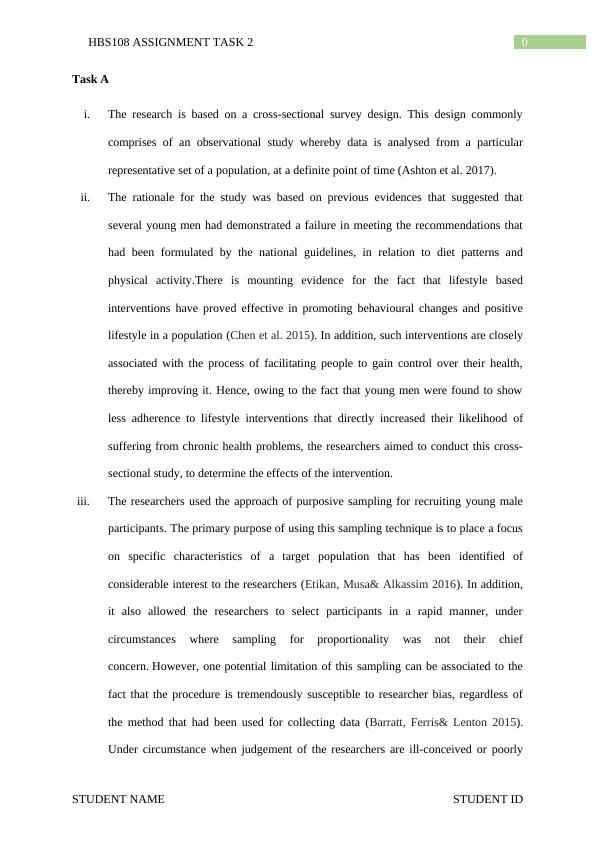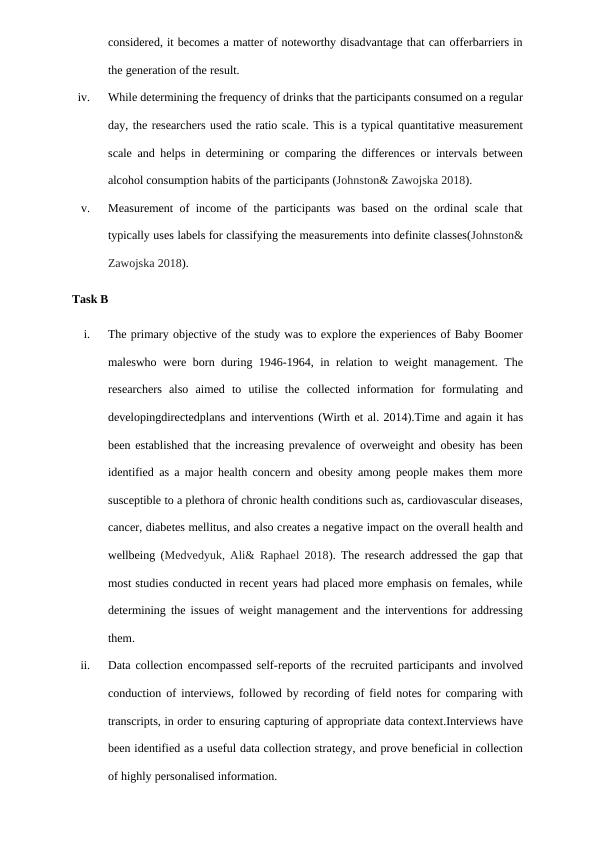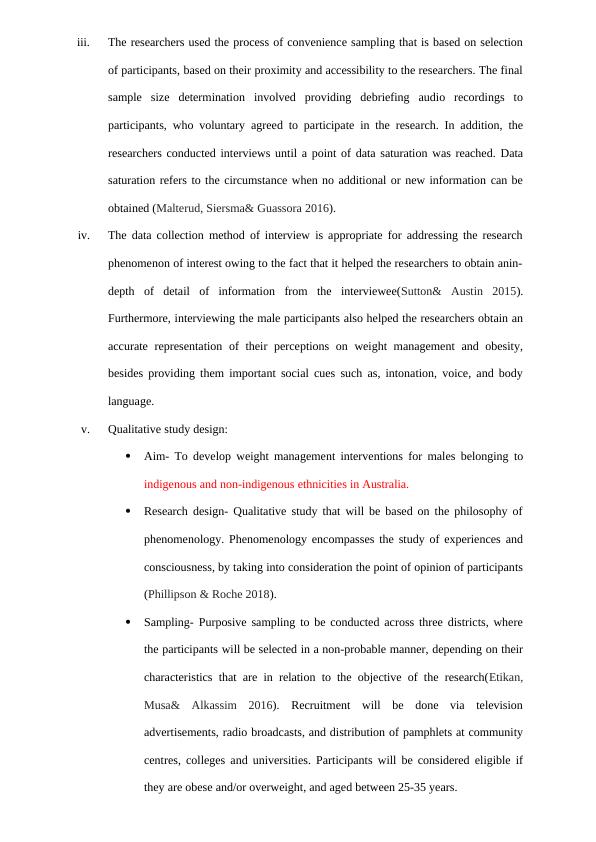Research Design and Sampling Methods in Health Studies
Added on 2023-01-10
8 Pages2029 Words56 Views
0HBS108 ASSIGNMENT TASK 2
Task A
i. The research is based on a cross-sectional survey design. This design commonly
comprises of an observational study whereby data is analysed from a particular
representative set of a population, at a definite point of time (Ashton et al. 2017).
ii. The rationale for the study was based on previous evidences that suggested that
several young men had demonstrated a failure in meeting the recommendations that
had been formulated by the national guidelines, in relation to diet patterns and
physical activity.There is mounting evidence for the fact that lifestyle based
interventions have proved effective in promoting behavioural changes and positive
lifestyle in a population (Chen et al. 2015). In addition, such interventions are closely
associated with the process of facilitating people to gain control over their health,
thereby improving it. Hence, owing to the fact that young men were found to show
less adherence to lifestyle interventions that directly increased their likelihood of
suffering from chronic health problems, the researchers aimed to conduct this cross-
sectional study, to determine the effects of the intervention.
iii. The researchers used the approach of purposive sampling for recruiting young male
participants. The primary purpose of using this sampling technique is to place a focus
on specific characteristics of a target population that has been identified of
considerable interest to the researchers (Etikan, Musa& Alkassim 2016). In addition,
it also allowed the researchers to select participants in a rapid manner, under
circumstances where sampling for proportionality was not their chief
concern. However, one potential limitation of this sampling can be associated to the
fact that the procedure is tremendously susceptible to researcher bias, regardless of
the method that had been used for collecting data (Barratt, Ferris& Lenton 2015).
Under circumstance when judgement of the researchers are ill-conceived or poorly
STUDENT NAME STUDENT ID
Task A
i. The research is based on a cross-sectional survey design. This design commonly
comprises of an observational study whereby data is analysed from a particular
representative set of a population, at a definite point of time (Ashton et al. 2017).
ii. The rationale for the study was based on previous evidences that suggested that
several young men had demonstrated a failure in meeting the recommendations that
had been formulated by the national guidelines, in relation to diet patterns and
physical activity.There is mounting evidence for the fact that lifestyle based
interventions have proved effective in promoting behavioural changes and positive
lifestyle in a population (Chen et al. 2015). In addition, such interventions are closely
associated with the process of facilitating people to gain control over their health,
thereby improving it. Hence, owing to the fact that young men were found to show
less adherence to lifestyle interventions that directly increased their likelihood of
suffering from chronic health problems, the researchers aimed to conduct this cross-
sectional study, to determine the effects of the intervention.
iii. The researchers used the approach of purposive sampling for recruiting young male
participants. The primary purpose of using this sampling technique is to place a focus
on specific characteristics of a target population that has been identified of
considerable interest to the researchers (Etikan, Musa& Alkassim 2016). In addition,
it also allowed the researchers to select participants in a rapid manner, under
circumstances where sampling for proportionality was not their chief
concern. However, one potential limitation of this sampling can be associated to the
fact that the procedure is tremendously susceptible to researcher bias, regardless of
the method that had been used for collecting data (Barratt, Ferris& Lenton 2015).
Under circumstance when judgement of the researchers are ill-conceived or poorly
STUDENT NAME STUDENT ID

considered, it becomes a matter of noteworthy disadvantage that can offerbarriers in
the generation of the result.
iv. While determining the frequency of drinks that the participants consumed on a regular
day, the researchers used the ratio scale. This is a typical quantitative measurement
scale and helps in determining or comparing the differences or intervals between
alcohol consumption habits of the participants (Johnston& Zawojska 2018).
v. Measurement of income of the participants was based on the ordinal scale that
typically uses labels for classifying the measurements into definite classes(Johnston&
Zawojska 2018).
Task B
i. The primary objective of the study was to explore the experiences of Baby Boomer
maleswho were born during 1946-1964, in relation to weight management. The
researchers also aimed to utilise the collected information for formulating and
developingdirectedplans and interventions (Wirth et al. 2014).Time and again it has
been established that the increasing prevalence of overweight and obesity has been
identified as a major health concern and obesity among people makes them more
susceptible to a plethora of chronic health conditions such as, cardiovascular diseases,
cancer, diabetes mellitus, and also creates a negative impact on the overall health and
wellbeing (Medvedyuk, Ali& Raphael 2018). The research addressed the gap that
most studies conducted in recent years had placed more emphasis on females, while
determining the issues of weight management and the interventions for addressing
them.
ii. Data collection encompassed self-reports of the recruited participants and involved
conduction of interviews, followed by recording of field notes for comparing with
transcripts, in order to ensuring capturing of appropriate data context.Interviews have
been identified as a useful data collection strategy, and prove beneficial in collection
of highly personalised information.
the generation of the result.
iv. While determining the frequency of drinks that the participants consumed on a regular
day, the researchers used the ratio scale. This is a typical quantitative measurement
scale and helps in determining or comparing the differences or intervals between
alcohol consumption habits of the participants (Johnston& Zawojska 2018).
v. Measurement of income of the participants was based on the ordinal scale that
typically uses labels for classifying the measurements into definite classes(Johnston&
Zawojska 2018).
Task B
i. The primary objective of the study was to explore the experiences of Baby Boomer
maleswho were born during 1946-1964, in relation to weight management. The
researchers also aimed to utilise the collected information for formulating and
developingdirectedplans and interventions (Wirth et al. 2014).Time and again it has
been established that the increasing prevalence of overweight and obesity has been
identified as a major health concern and obesity among people makes them more
susceptible to a plethora of chronic health conditions such as, cardiovascular diseases,
cancer, diabetes mellitus, and also creates a negative impact on the overall health and
wellbeing (Medvedyuk, Ali& Raphael 2018). The research addressed the gap that
most studies conducted in recent years had placed more emphasis on females, while
determining the issues of weight management and the interventions for addressing
them.
ii. Data collection encompassed self-reports of the recruited participants and involved
conduction of interviews, followed by recording of field notes for comparing with
transcripts, in order to ensuring capturing of appropriate data context.Interviews have
been identified as a useful data collection strategy, and prove beneficial in collection
of highly personalised information.

iii. The researchers used the process of convenience sampling that is based on selection
of participants, based on their proximity and accessibility to the researchers. The final
sample size determination involved providing debriefing audio recordings to
participants, who voluntary agreed to participate in the research. In addition, the
researchers conducted interviews until a point of data saturation was reached. Data
saturation refers to the circumstance when no additional or new information can be
obtained (Malterud, Siersma& Guassora 2016).
iv. The data collection method of interview is appropriate for addressing the research
phenomenon of interest owing to the fact that it helped the researchers to obtain anin-
depth of detail of information from the interviewee(Sutton& Austin 2015).
Furthermore, interviewing the male participants also helped the researchers obtain an
accurate representation of their perceptions on weight management and obesity,
besides providing them important social cues such as, intonation, voice, and body
language.
v. Qualitative study design:
Aim- To develop weight management interventions for males belonging to
indigenous and non-indigenous ethnicities in Australia.
Research design- Qualitative study that will be based on the philosophy of
phenomenology. Phenomenology encompasses the study of experiences and
consciousness, by taking into consideration the point of opinion of participants
(Phillipson & Roche 2018).
Sampling- Purposive sampling to be conducted across three districts, where
the participants will be selected in a non-probable manner, depending on their
characteristics that are in relation to the objective of the research(Etikan,
Musa& Alkassim 2016). Recruitment will be done via television
advertisements, radio broadcasts, and distribution of pamphlets at community
centres, colleges and universities. Participants will be considered eligible if
they are obese and/or overweight, and aged between 25-35 years.
of participants, based on their proximity and accessibility to the researchers. The final
sample size determination involved providing debriefing audio recordings to
participants, who voluntary agreed to participate in the research. In addition, the
researchers conducted interviews until a point of data saturation was reached. Data
saturation refers to the circumstance when no additional or new information can be
obtained (Malterud, Siersma& Guassora 2016).
iv. The data collection method of interview is appropriate for addressing the research
phenomenon of interest owing to the fact that it helped the researchers to obtain anin-
depth of detail of information from the interviewee(Sutton& Austin 2015).
Furthermore, interviewing the male participants also helped the researchers obtain an
accurate representation of their perceptions on weight management and obesity,
besides providing them important social cues such as, intonation, voice, and body
language.
v. Qualitative study design:
Aim- To develop weight management interventions for males belonging to
indigenous and non-indigenous ethnicities in Australia.
Research design- Qualitative study that will be based on the philosophy of
phenomenology. Phenomenology encompasses the study of experiences and
consciousness, by taking into consideration the point of opinion of participants
(Phillipson & Roche 2018).
Sampling- Purposive sampling to be conducted across three districts, where
the participants will be selected in a non-probable manner, depending on their
characteristics that are in relation to the objective of the research(Etikan,
Musa& Alkassim 2016). Recruitment will be done via television
advertisements, radio broadcasts, and distribution of pamphlets at community
centres, colleges and universities. Participants will be considered eligible if
they are obese and/or overweight, and aged between 25-35 years.

End of preview
Want to access all the pages? Upload your documents or become a member.
Related Documents
Health Information and Datalg...
|9
|2081
|80
Reducing overweight and obesity in Australian menlg...
|9
|2635
|94
The lifeline of chronic illness managementlg...
|8
|2404
|20
Effectiveness of Lifestyle Intervention in Preventing Obesity in Children and Young Adultslg...
|22
|3771
|75
Aging and Weight Loss Nursing Assignment 2022lg...
|8
|2318
|24
Community Teaching Plan Summary 2022lg...
|10
|2078
|29
